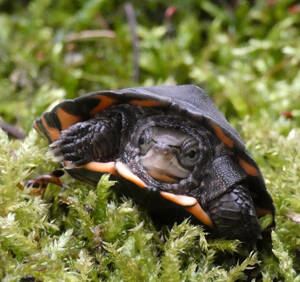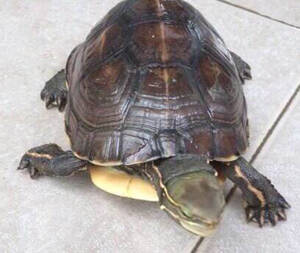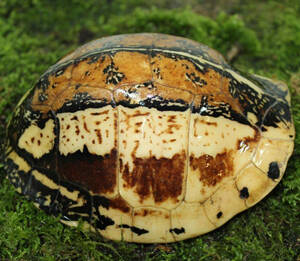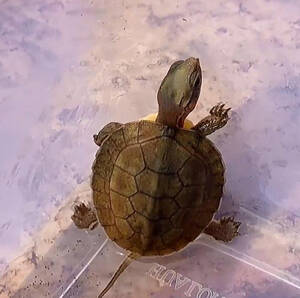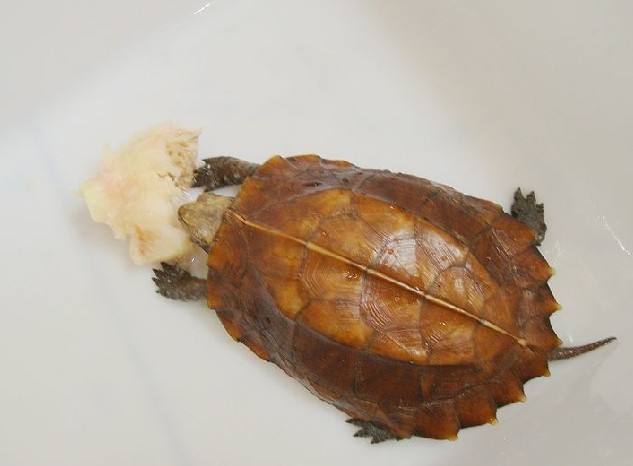Golden-headed Box Turtle
IUCN
LCBasic Information
Scientific classification
- name:Golden-headed Box Turtle
- Scientific Name:Golden-headed Box Turtle,Golden turtle, splint turtle, yellow turtle
- Outline:Testudines
- Family:Testudinidae B.turtle
Vital signs
- length:8-15cm
- Weight:750-1000g
- lifetime:40-60years
Feature
The head is golden yellow, with slightly yellowish brown on the sides and three thin black stripes
Distribution and Habitat
The golden-headed box turtle is endemic to China and is distributed in the mountainous areas of Anhui Province. In Anhui, it is distributed in the Qingyi River basin, a tributary of the Yangtze River, including the Guba section of Caoxi River (Guba River), a tributary of Qinxi River in Jing County, and the Aimin to Caicun section of Tingxi River, the Gufeng to Changqiao section of Gufeng River, and the section of Qingxi River above Meixi in Yi County (Meixi River). The administrative areas include Caicun Town, Jingchuan Town, Changqiao Township in Jing County and Hongxing Township and Meixi Township in Yi County, with a cumulative distribution area of no more than 120 square kilometers.
Appearance
The body is medium, with a carapace length of 89.3-138.6 mm, a width of 65.6-92.6 mm, and a height of 29.2-50.8 mm. The ratio of shell length to shell height is 2.7-3.1. The head is of moderate size, with a smooth back, a snout slightly protruding from the upper jaw, a slightly curved upper jaw, and a lower jaw shorter than the upper jaw. The orbital diameter is significantly larger than the snout length.
The carapace is oval, with rounded front and rear edges, a high ridge, but a relatively flat ridge. There are obvious ridges, but no side edges. The cervical shield is short and bell-shaped; there are five vertebral shields, the first vertebral shield is pentagonal, with the center of the front edge protruding forward, and the front edge is wider than the rear edge; the second, third, and fourth vertebral shields are basically hexagonal, with a width greater than the length; the fifth vertebral shield is fan-shaped, with a width greater than the length. There are 4 pairs of rib shi
Details
Golden-headed Box Turtle, with two subspecies.
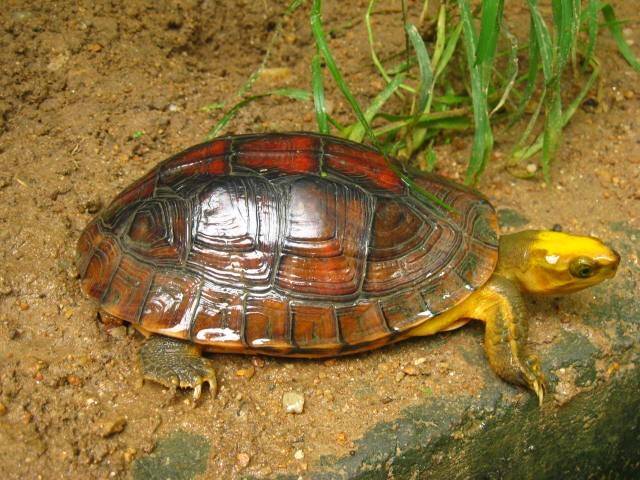
In the late 1980s, Luo Bitao and Zong Yu, based on the No. 3 model specimen obtained from Nanling, believed that the turtle belonged to a new species of box turtles and named it the golden-headed box turtle based on the morphological taxonomy of turtles. The description of the morphology of the box turtle fossils from the Pliocene in Tongshan, Anhui, shows that the golden-headed box turtle is very similar to it and its origin is also similar, indicating that the turtle is one of the most ancient creatures in the area. According to the classification of turtles and tortoises in China, it belongs to the genus Cuora of the family Testudinidae, order Testudinata, class Reptilia, and its scientific name is Cuora aurocapitata.
The golden-headed box turtle lives in ravines in hilly areas or ponds in mountainous areas with clear water. It is also commonly seen in bushes and grass not far from the water. It is mostly nocturnal, hiding under stones or slabs during the day and going out to forage at night. It likes to eat fish, shrimp, tadpoles, various insects, especially dragonfly larvae. Under captive conditions, it can eat small fish, shrimp, snail meat, tadpoles, etc., and also eat a small amount of plants. The feeding and activity period is from May to October each year, and the hibernation period is from November to April of the following year. The golden-headed box turtle is bold and quite human. Sometimes before and after the owner feeds it, it will crawl over to play with the owner or crawl with the owner, and nod to the owner frequently after a full meal.
Under artificial breeding, the golden-headed box turtle often hides in deep water areas and likes to hide in the cracks of the rocks at the bottom of the water. When the ambient temperature is around 15℃, it will stop eating or eat less, enter hibernation at around 10℃, and can eat normally at 20℃. The hibernation period is from November to March of the following year, and it enters a semi-dormant state when the water temperature exceeds 30℃ from June to August.
Female turtles weighing more than 300 grams can reach sexual maturity. Male turtles generally reach sexual maturity when they weigh more than 120 grams. April-May and September-October are the estrus period for female golden-headed box turtles, and male turtles can estrus at any time except hibernation. The egg-laying period is from the end of July to the beginning of August, and eggs are laid once a year, which can be produced in two batches, with 2 eggs in each batch. The eggs are milky white, oval, with a diameter of 39.5-41.5 mm × 20.7-22.4 mm and a weight of 12.0-14.8 grams. The baby turtles hatch in about 60 days.
The golden-headed box turtle is an aquatic turtle that can move in deep waters, but there must be stones exposed above the water scattered in the water for the turtles to rest. If the breeding tank is large or in a cement pool, it should be arranged in a "water-land" style, with the land area less than 1/2 of the pool area. Although the golden-headed box turtle is a rare turtle, it is not difficult to breed it. Fresh fish and shrimp should be the main feeding. Stop feeding below 20℃. When breeding golden-headed box turtles, pay special attention to the maintenance of water quality and change water in time. In autumn, when the temperature is below 15℃, move the turtle into an indoor container for wintering. Put water in the container, the water depth should reach the turtle's back, and maintain 4-10℃. The wintering survival rate can generally reach 100%.
The wild natural resources of golden-headed box turtles are extremely scarce. As of 2007, it is estimated that the total number of wild and domestically raised in China may not exceed 1,000.
The main factors affecting the ecological environment of the golden-headed box turtle are: the structure of plant communities has been destroyed, mainly manifested in the frequent felling of natural forests and secondary forests, landslides, and residents in some areas of the habitat privately connected drinking water pipes at the outlet of the stream, causing intermittent dry seasons; due to the demand for artificial construction, a large amount of sand has been excavated; the stream water environment has tended to deteriorate, with a large amount of domestic water flowing in and garbage dumped at will; human poaching has always existed; tributaries have been poured with industrial and agricultural production water, and the Tingxi River section has been over-developed for tourism (all kinds of fashionable artificial rafting tours, etc.); there are many artificial dams, hydropower stations, and paper mills in the tributary rivers; and artificial fishing and shrimping in the tributary rivers. There are many factors that should be the important factors that lead to the lack of living conditions for the golden-headed box turtle in the main rivers of Caoxi River, Gufeng River, Tingxi River, and Qingxi River that are connected to Qingyi River.
Only the Yixian County Government has officially approved in 2007 to plan and build the Yixian Qingxi Nature Reserve in Hongxing Township. In 2010, the Anhui Provincial Forestry Department included the protection of the golden-headed box turtle in the "Endangered Wildlife Habitat Maintenance and Renovation" project. The project is unsustainable due to the lack of relevant policy project funding support; in Jingxian, where a large number of golden-headed box turtles are caught, there is still no special protection and management agency.
The golden-headed box turtle can be eaten and viewed, its shell can be used as medicine, and can be used to cultivate green-haired turtles.
Listed in the "Red List of Endangered Species of the World Conservation Union" (IUCN 2000 ver 3.1) - Critically Endangered (CR).
Listed in the "Convention on International Trade in Endangered Species of Wild Fauna and Flora" (CITES) - Appendix II.
Listed in the "China Biodiversity Red List - Vertebrate Volume" (Reptiles) - Critically Endangered (CR).
Listed in the "List of Terrestrial Wildlife with Important Economic and Scientific Research Value under State Protection" issued by the State Forestry Administration of China on August 1, 2000.
Listed in the "Red Data of Endangered Animals in China" - Critically Endangered (CR).
Listed in the "List of National Key Protected Aquatic Wildlife in China Revised by the Ministry of Agriculture in 2000" - Level II.
In 1992, Anhui Province listed the golden-headed box turtle as a Class I protected animal in Anhui Province.
Protect wild animals and eliminate game.
Maintaining ecological balance is everyone's responsibility!



